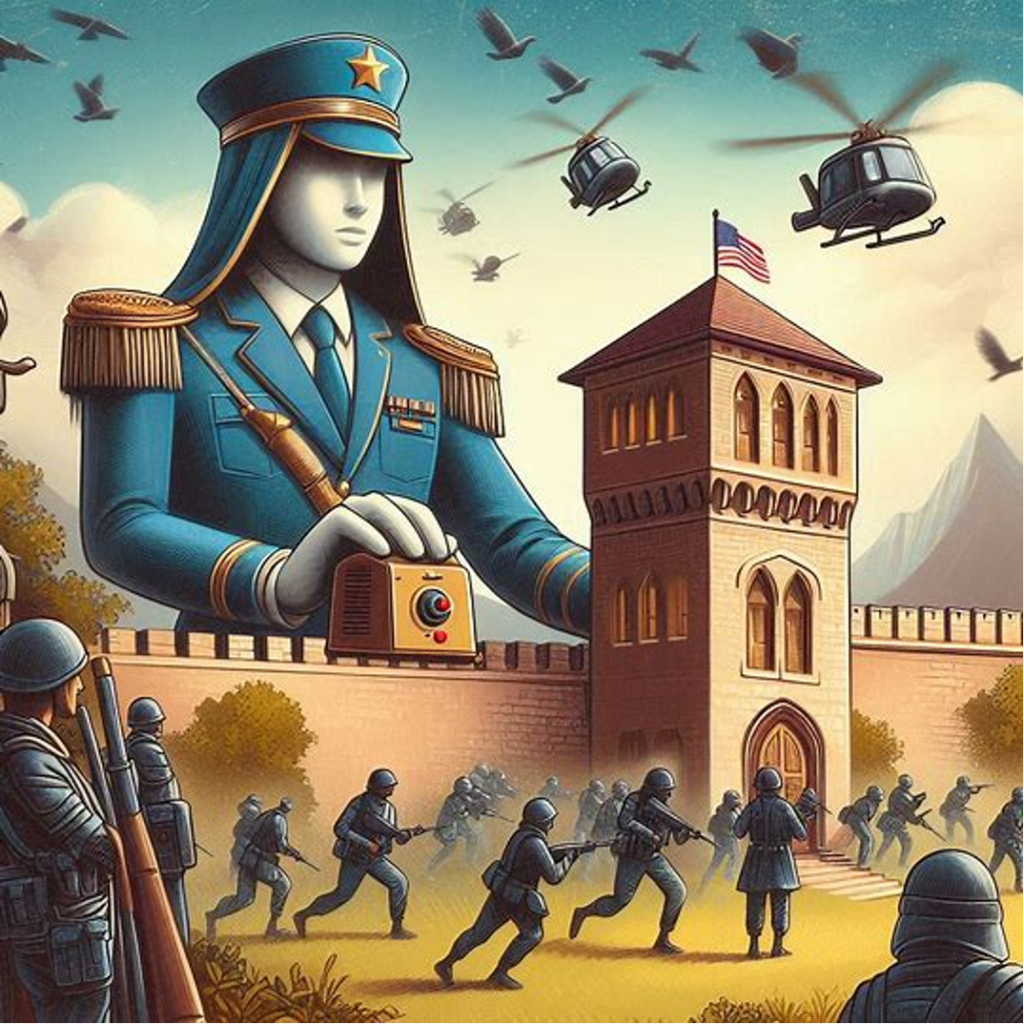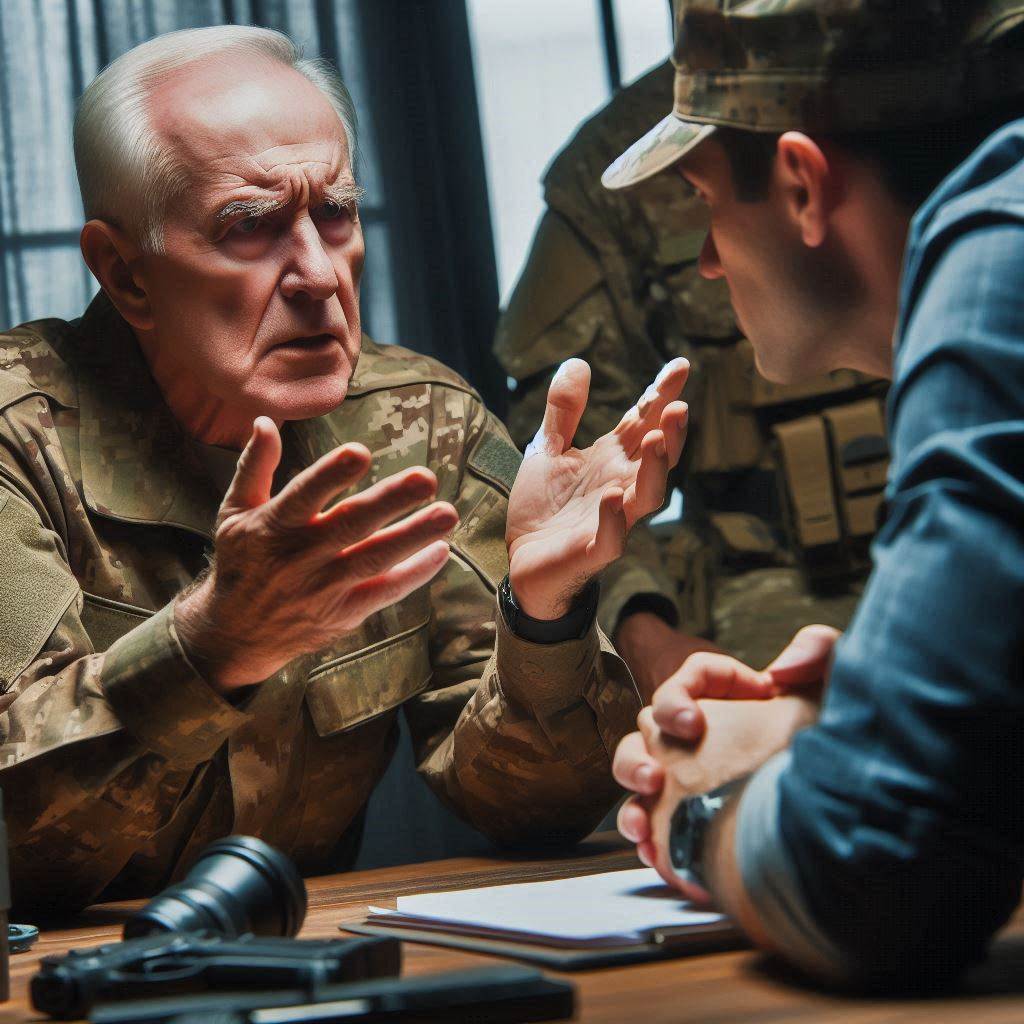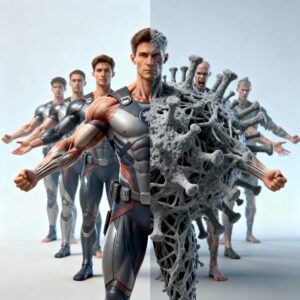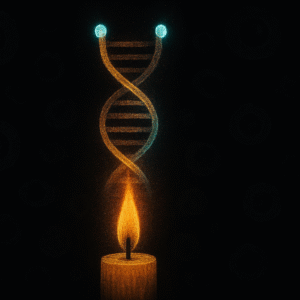In the intricate world of human biology, an unending battle rages between our cells and invading pathogens. This is a tale of sacrifice, strategy, and survival—a story of how our bodies defend themselves at the cellular level. Welcome to the world of necroptosis and immune response, where cellular self-destruction becomes a powerful weapon against disease.
In the last article I delved into the concept of how cells sacrifice themselves to keep our body alive.
Cells frequently engage in self-destruction as a defense mechanism against microbial invasions. This process involves intricate pathways and molecules. In this article, I’ll narrate these concepts through a cinematic story, allowing you to enjoy the read while grasping the essential elements of this complex topic.
You are going to witness a thrilling tale of sacrifice, strategy, and survival in the microscopic world of Cellville!
Presenting…………………..
Suicide Squad- Cellville’s Last Stand
Starring:
🎬 Captain Caspase as The Orderly Protector
The meticulous leader of the Apoptosis Squad, Captain Caspase embodies the principle of clean and efficient cell death, ensuring a healthier Cellville.
🎬 Commander RIPK3 as The Resolute Defender
The tough-as-nails commander of the Necroptosis Unit, RIPK3 takes charge when the situation demands bold action and aggressive strategies against invading pathogens.
🎬 RIPK1 as The Loyal Sidekick
Supporting Commander RIPK3, RIPK1 is the steadfast second-in-command, forming the vital necrosome complex to initiate necroptosis.
🎬 MLKL as The Demolition Expert
With a flair for chaos, MLKL is ready to punch holes in infected cells, unleashing havoc on viral invaders and turning the tide of battle.
🎬 DAI as The Keen Scout
The sharp-eyed reconnaissance expert, DAI detects viral threats with precision, serving as the early warning system for the Necroptosis Unit.
🎬 Chief Interferon as The Alert Guardian
At the helm of the Interferon Defense System, Chief Interferon initiates crucial antiviral responses and keeps the city informed of potential dangers.
🎬 Toll-like Receptor 4 (TLR4) as The Watchful Sentinel
A vigilant pattern recognition receptor, TLR4 detects signals of danger, rallying the innate immune forces into action against invaders.
🎬 Macrophages as The Clean-Up Crew
The dedicated sanitation workers of Cellville, these immune cells engulf and digest debris and pathogens, ensuring a clean and healthy environment.
🎬 Dendritic Cells as The Knowledgeable Messengers
These immune cells are tasked with processing viral antigens and communicating vital information to activate the adaptive immune response.
🎬 Helper T Cells as The Coordinators of Defense
Working tirelessly to rally the immune forces, these T cells activate B cells and cytotoxic T cells to eliminate infected cells.
🎬 Cytotoxic T Cells as The Precision Assassins
Specialized immune warriors, cytotoxic T cells track down and destroy infected cells with surgical precision, safeguarding Cellville’s health.
The movie begins now!
The Bustling Metropolis of Cellville
Imagine a vast city called Cellville, representing a small part of the human body. Skyscrapers of organelles tower above, while busy streets pulse with the flow of proteins and molecules. At the heart of Cellville stands the imposing Central Dogma Tower, where the city’s genetic code is carefully guarded.
Like any thriving metropolis, Cellville faces constant threats. To combat these dangers, the city relies on its elite defense force: The Cellville Troopers.
The Guardians of Cellular Health
In Cellville’s security headquarters, two units stand ready to protect the city:
- The Apoptosis Squad: Led by the meticulous Captain Caspase, this team specializes in clean, orderly cell death. Their motto, “Clean Death for a Healthier City,” reflects their approach to eliminating damaged or infected cells without causing inflammation.
- The Necroptosis Unit: Commanded by the tough-as-nails RIPK3, this elite force takes a more drastic approach to cellular defense. Their methods are messy but effective, especially when conventional tactics fail.
Little did they know that their skills would soon be put to the ultimate test.
The Viral Invasion Begins
On what seemed like an ordinary day in Cellville, alarm bells suddenly rang out across the city. A horde of Viral Invaders, led by the notorious Influenza A Virus gang, had breached the outer defenses!
The First Line of Defense
As news of the invasion spread, Cellville’s first line of defense sprang into action. The Interferon Type I Defense System, a sophisticated early warning network, detected the invasion and broadcast alert signals throughout the city.

Chief Interferon stood before a massive screen, watching as data streamed in from sensors throughout Cellville. “We’ve got multiple alerts in the Eastern Quarter,” she announced to her team. “Initiate the antiviral response!”
At her command, signals began broadcasting throughout Cellville, alerting cells to the potential danger and triggering the production of antiviral proteins. In healthy cells across the city, nuclei began transcribing genes for virus-fighting molecules, while surface receptors became more vigilant for signs of infection.
But the crafty viruses had a trick up their sleeve. The Influenza A Virus deployed its secret weapon: the NS1 protein, capable of jamming Cellville’s Interferon signals.
“Our alerts aren’t getting through!” cried one of Chief Interferon’s assistants. “The viruses are blocking our transmissions!”
Chief Interferon’s face hardened. “Alert the Mayor. We need to activate our secondary defenses.”
The Apoptosis Squad Takes Action
As the Interferon System struggled to contain the threat, Captain Caspase and the Apoptosis Squad rushed to confront the viral invasion. They moved swiftly from cell to cell, identifying those that had been infected.
“Attention infected cell,” Captain Caspase announced, “by the authority of Cellville’s defense protocols, you have been marked for termination. Please cease all functions and prepare for dismantling.”
But something was terribly wrong. Many of the infected cells weren’t responding to the Apoptosis Squad’s signals. The viruses had evolved, developing proteins that interfered with the apoptosis process.
“It’s not working!” one of the squad members cried out. “They’ve developed apoptosis inhibitors!”
Captain Caspase watched in horror as the viral infection continued to spread. “Fall back!” he ordered. “We need to regroup and come up with a new strategy!”
The Necroptosis Protocol: A Desperate Measure
In the grand City Hall of Cellville, Mayor Cellman paced nervously. Reports were flooding in from all quarters of the city, painting a grim picture of the escalating crisis.
“The Interferon Type I Defense System has failed,” reported the Chief of Communications. “Our signals are being jammed, and many cells aren’t receiving the antiviral alerts.”
“And the Apoptosis Squad?” Mayor Cell asked, dreading the answer.
“Overwhelmed, sir. The viruses have found a way to block their protocols.”
Mayor Cellman’s face fell. He knew there was only one option left. Reaching for the secure phone on his desk, he dialed a number he’d hoped never to use.

“Commander RIPK3? This is Mayor Cellman. We need you. Cellville needs you. It’s time to initiate the Necroptosis Protocol.”
Assembling the Necroptosis Unit
In the Necroptosis Unit’s headquarters, sirens blared as RIPK3 briefed the team.
“This is not a drill,” RIPK3 announced, his voice grave. “We have a city-wide viral invasion that has overwhelmed our primary defenses. Mayor Cellman has given us full authority to initiate the Necroptosis Protocol.“
RIPK1, RIPK3‘s loyal second-in-command, stepped forward. “What’s our strategy, Commander?”
RIPK3 pointed to a map of Cellville. “We’ll start in the Eastern Quarter, where the infection is heaviest. RIPK1, you and I will form the core of the necrosome complex. MLKL, you’ll be our demolitions expert. Your job is to punch holes in the cell membranes once we give the signal.”
MLKL, a stocky protein with a penchant for explosives, nodded eagerly.
“What about me, boss?” came a voice from the back. It was DAI, the team’s reconnaissance expert.
“DAI, you have the most crucial job of all,” RIPK3 replied. “You’re our early warning system. Use those Z-alpha domains of yours to detect any viral RNA or DNA. The moment you sense something, you signal us to start the necroptosis process.”
The team looked at each other, determination in their eyes. They knew that their actions would result in the destruction of many of Cellville’s cells, but it was a necessary sacrifice to save the city.
The Battle for Cellville
The Necroptosis Unit moved through the streets of Cellville with grim determination. Unlike the neat, orderly processes of the Apoptosis Squad, their approach was one of controlled chaos.
As they entered the first infected neighborhood, DAI’s sensors lit up. “Commander! I’m detecting Z-form nucleic acids… it’s viral RNA!”
RIPK3 nodded to RIPK1, and together they began the complex dance of protein interactions that would form the necrosome. As they did, MLKL stood ready, waiting for the signal to ignite the explosives.
In infected cells throughout the area, the necroptosis process began. Cell membranes burst open, spilling their contents into the streets of Cellville. Among the cellular debris were crucial signaling molecules—the Damage-Associated Molecular Patterns, or DAMPs.
“Now we wait,” RIPK3 said, watching as the DAMPs spread through the area. “These signals will alert the Immune System Army. They’re our best hope for turning the tide of this battle.”
The Immune System Responds
As the DAMPs spread through Cellville, they reached the watchtowers of the Innate Immune System. Here, Pattern Recognition Receptors (PRRs) stood vigilant, always on the lookout for signs of danger.
“Alert! Alert!” cried Toll-like Receptor 4 (TLR4). “DAMPs detected! Initiate innate immune response!”
Throughout Cellville, innate immune cells sprang into action. Macrophages, the city’s primary sanitation workers, began to mobilize, moving towards the areas of infection to engulf debris and viral particles.
Dendritic Cells, the messengers of the immune system, picked up antigens from the viral debris and began their journey to the Lymph Node Outposts, where they would alert the Adaptive Immune System.
The Cytokine Storm
As the battle raged on, the air in Cellville became thick with cytokines—molecular messages broadcasting the distress of the city. Interleukins, Tumor Necrosis Factors, and Interferons filled the streets, calling for reinforcements and directing the immune response.
But the intensity of the response brought its own dangers. In some areas of Cellville, the cytokine levels became so high that they began to damage even healthy cells.

“The cytokine storm is getting out of control!” RIPK1 reported to RIPK3. “If we don’t manage this, we could end up doing more harm than the viruses!”
RIPK3 nodded grimly. “This is the risk of necroptosis. Our job is to stop the infection, but we must be careful not to destroy the very city we’re trying to save.”
The Adaptive Immune System Joins the Fray
In the Lymph Node Outposts surrounding Cellville, the Adaptive Immune System stirred to life. Dendritic Cells arrived, presenting viral antigens to the T Cell commanders.
“We have a positive ID on the invaders,” announced Helper T Cell. “B Cells, begin producing antibodies specific to these viral antigens. Cytotoxic T Cells, prepare for deployment. Your mission is to find and eliminate any cell that’s been infected by these viruses.”
As the newly activated immune cells entered Cellville, the tide of the battle slowly began to turn. Antibodies latched onto free-floating viruses, marking them for destruction. Cytotoxic T Cells moved methodically through the streets, identifying and eliminating infected cells with surgical precision.
The Turning Point
Despite the full mobilization of Cellville’s defenses, pockets of viral resistance remained. In a bold move, RIPK3 decided to take the fight directly to the viral headquarters.
“RIPK1, MLKL, with me,” RIPK3 commanded. “DAI, you stay back and coordinate with the Immune System forces. If we don’t make it back… initiate city-wide necroptosis. It’s better than letting the viruses take over.”
The team fought their way through swarms of viruses, finally reaching the central viral command center. There, they found the Influenza A Virus leader, H1N1, orchestrating the invasion.
“It’s over, H1N1,” RIPK3 declared. “Surrender now, or we’ll take this whole sector down with us.”
H1N1 sneered. “You don’t have the strength to stop us all!”
“Maybe not,” RIPK3 replied, nodding to MLKL. “But we don’t need to stop you all. We just need to slow you down long enough for the Adaptive Immune System to finish the job.”

With that, MLKL detonated, causing a chain reaction of necroptosis throughout the viral headquarters. The explosion of infected cells released a massive wave of DAMPs, supercharging the immune response.
As the viral command structure crumbled, the Immune System forces pressed their advantage. Macrophages swarmed in, engulfing viral particles and cellular debris. Antibodies neutralized free-floating viruses, while Cytotoxic T Cells eliminated the last of the infected cells.
In the streets of Cellville, citizens cheered as news of the victory spread. The Viral Invasion had been defeated, though at a great cost.
The Aftermath and Lessons Learned
In the days that followed, Cellville began the process of rebuilding. The Phagocyte Sanitation Department worked overtime, clearing away the debris left by the battle. In the gaps left by necroptosis, stem cells began the process of regenerating lost tissue.
Mayor Cellman called a city-wide assembly to address the citizens of Cellville. “We have weathered a great storm,” he announced. “The Viral Invasion tested our defenses like never before. But thanks to the brave actions of the Necroptosis Unit, the tireless work of our Immune System, and the resilience of every citizen of Cellville, we have emerged victorious.”

The battle had taught Cellville valuable lessons about its cellular defense mechanisms:
- The Power of Sacrifice: Necroptosis, though destructive, proved to be a crucial last line of defense against pathogens that could evade other cell death pathways.
- The Importance of Coordination: The successful defense required the coordinated efforts of multiple systems—from the initial Interferon response to the Adaptive Immune System’s targeted attacks.
- The Double-Edged Sword of Inflammation: While the inflammatory response triggered by necroptosis was crucial for activating the immune system, it also posed risks if left unchecked.
- Adaptability is Key: The ability to switch between different cell death mechanisms (apoptosis and necroptosis) allowed Cellville to respond effectively to a wide range of threats.
- The Ongoing Arms Race: The viruses’ ability to inhibit apoptosis highlighted the constant evolution of pathogens and the need for multiple defense strategies.
In the wake of the invasion, Cellville underwent significant changes. The Programmed Cell Death Department was reorganized, with the Apoptosis Squad and Necroptosis Unit working more closely together. New failsafes were put in place to prevent the unchecked activation of necroptosis, while still maintaining it as a crucial line of defense.
Research teams worked tirelessly to develop new antiviral strategies, studying the proteins used by the Viral Invaders to evade Cellville’s defenses. The Interferon Type I Defense System received a major upgrade, improving its ability to detect and respond to future threats.
Conclusion Remarks On The Ongoing Battle for Cellular Health
As life in Cellville returned to normal, RIPK3 and the heroes of the Necroptosis Unit resumed their vigilant watch over the city. They knew that new threats would always emerge, evolving and adapting to challenge the city’s defenses. But with the combined strength of Apoptosis, Necroptosis, and the Immune System working in harmony, Cellville stood ready to face whatever the future might bring.
The Viral Invasion had demonstrated the delicate balance between life and death at the cellular level. Necroptosis, once seen as a last resort, had proven its worth as a powerful tool in the arsenal of cellular defense. It showed that sometimes, sacrifice is necessary for survival.
The Movie Ends!
This topic is complex, even for seasoned scientists. If you’ve read this far and enjoyed the story, give yourself a pat on the back for grasping such intricate material. That’s an impressive achievement in itself!
If you want a simplified understanding of how our immune system works in general, please read my post HERE.

As researchers in the human world continue to study necroptosis and immune responses, the lessons learned from battles like the one in Cellville provide valuable insights. These insights could lead to new treatments for viral infections, autoimmune disorders, and even cancer.
The story of Cellville’s defense against the Viral Invasion serves as a reminder of the incredible complexity and resilience of our bodies. It highlights the constant evolutionary battle between our cellular defenses and the pathogens that seek to undermine them. In this microscopic war, cell death paradoxically becomes a powerful force for life, ensuring the survival of the organism as a whole.
As we marvel at the intricate dance of molecules and cells that keep us healthy, we gain a deeper appreciation for the silent battles being fought within us every day. The tale of necroptosis and immune response is not just a story of cellular sacrifice and defense—it’s the story of life itself, perpetually adapting, fighting, and surviving against all odds.
Hope you liked this way of presenting complex biological mechanisms in the form of a story. Please let me know your views.
Glossary
- Apoptosis: A process of programmed cell death where cells die in a controlled and orderly manner without causing inflammation.
- Necroptosis: A type of programmed cell death that results in the rupture of the cell membrane and inflammation, used as a defense mechanism when other methods fail.
- RIPK3 (Receptor-Interacting Protein Kinase 3): A protein that plays a crucial role in the process of necroptosis.
- RIPK1 (Receptor-Interacting Protein Kinase 1): A protein that works with RIPK3 to form the necrosome, a complex that triggers necroptosis.
- MLKL (Mixed Lineage Kinase Domain-Like Protein): A protein that becomes activated during necroptosis and disrupts cell membranes, leading to cell death.
- DAI (DNA-Dependent Activator of Interferon-Regulatory Factors): A protein that detects viral DNA or RNA and initiates an immune response.
- Interferon Type I: A group of proteins produced by cells in response to viral infections, which help to alert and activate the immune system.
- NS1 Protein (Nonstructural Protein 1): A protein produced by the Influenza A Virus that helps it evade the host’s immune response.
- DAMPs (Damage-Associated Molecular Patterns): Molecules released by stressed or dying cells that signal to the immune system that there is damage or infection.
- PRRs (Pattern Recognition Receptors): Proteins on the surface of immune cells that recognize common features of pathogens and activate the immune response.
- TLR4 (Toll-Like Receptor 4): A type of PRR that detects bacterial infections and triggers an immune response.
- Macrophages: Immune cells that engulf and digest cellular debris, pathogens, and other foreign substances.
- Dendritic Cells: Immune cells that process antigen material and present it to T cells, initiating an adaptive immune response.
- Helper T Cells: A type of T cell that plays a central role in the immune response by activating other immune cells.
- B Cells: Immune cells that produce antibodies specific to pathogens, helping to neutralize and eliminate them.
- Cytotoxic T Cells: Immune cells that kill infected cells by recognizing specific antigens presented by these cells.
- Antibodies: Proteins produced by B cells that specifically bind to and neutralize pathogens like viruses and bacteria.
- Caspase: A family of proteins that play an essential role in the process of apoptosis, leading to the orderly dismantling of the cell.
- Z-alpha Domains: Protein domains in DAI that recognize and bind to Z-form nucleic acids, indicating the presence of viral DNA or RNA.
- H1N1: A subtype of the Influenza A Virus, known for causing flu pandemics.
- Influenza A Virus: A virus that causes respiratory infections, commonly known as the flu.
- Cytokines: Signaling molecules that mediate and regulate immunity, inflammation, and hematopoiesis (formation of blood cellular components).
- Interleukins: A group of cytokines that were first seen to be expressed by white blood cells (leukocytes). They play roles in cell signaling, particularly in the immune system.
- Tumor Necrosis Factors (TNF): A group of cytokines involved in systemic inflammation and stimulation of the acute phase reaction.
- Interferons: A group of signaling proteins released by host cells in response to the presence of pathogens, such as viruses, bacteria, and parasites.
- Phagocytes: Cells that protect the body by ingesting harmful foreign particles, bacteria, and dead or dying cells.
- Adaptive Immune System: The part of the immune system that adapts its response to specific pathogens and retains memory of them for faster responses in the future.
- Innate Immune System: The part of the immune system that serves as a general defense against pathogens, providing an immediate response to infections.
- Stem Cells: Undifferentiated cells that can develop into different cell types and are crucial for tissue regeneration and repair.
- Z-form Nucleic Acids: A left-handed helical form of DNA or RNA that can be an indicator of viral presence.





